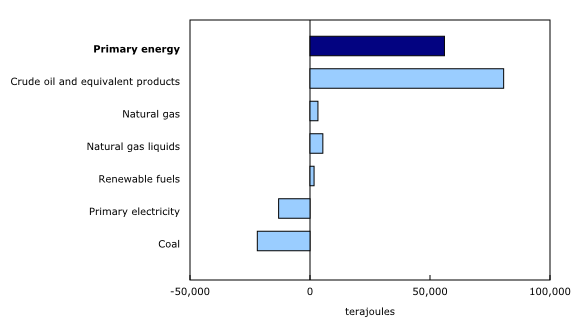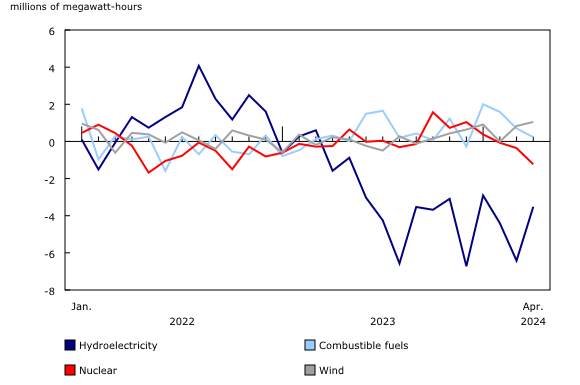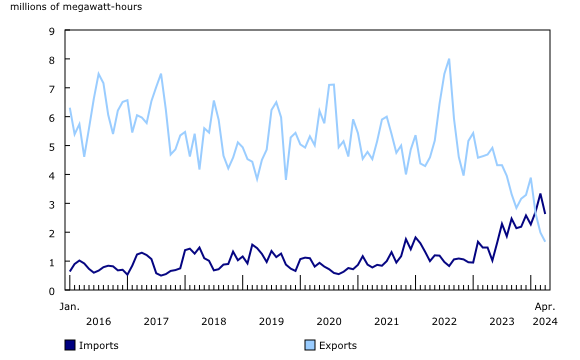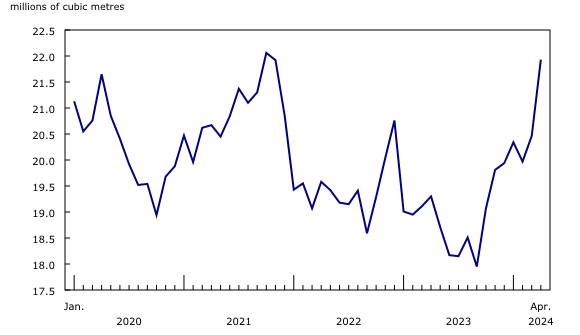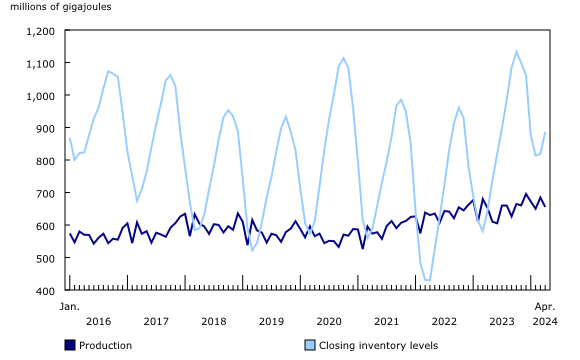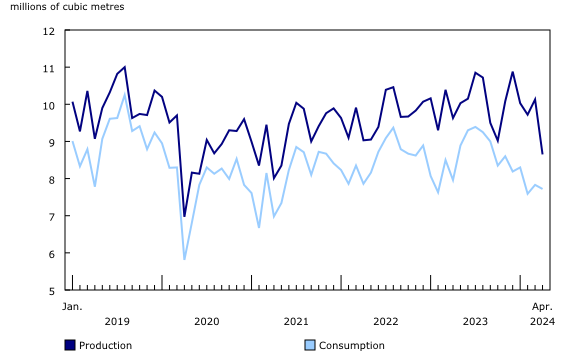Energy statistics, April 2024
Released: 2024-07-02
Primary energy production rose 3.0% in April with four of the six subsectors posting increases. Secondary energy production fell 11.4%, led by a decrease in refined petroleum products.
For more information on energy in Canada, including production, consumption, international trade, and much more, please visit the Canadian Centre for Energy Information portal and follow #energynews on social media.
Hydroelectricity shortfall drives electricity trade deficit in April
Total Canadian electricity generation declined 6.9% year over year to 45.7 million megawatt-hours (MWh) in April. Hydroelectric generation (-11.9% to 26.0 million MWh) accounted for most of the decrease due to persistent drought conditions across much of Canada. Meanwhile, nuclear generation (-19.1% to 5.2 million MWh) was down due to planned maintenance at Ontario's Bruce and New Brunswick's Point Lepreau nuclear generating stations. Generation from wind rose 28.5% to 4.7 million MWh, while generation from combustible fuels increased 2.6% to 9.2 million MWh.
Reduced electricity generation has resulted in lower export levels as well as an increased reliance on imports. Imports of electricity from the United States climbed 79.0% year over year to 2.6 million MWh in April, while exports to the United States fell 64.4% to 1.7 million MWh. Canada is generally a net electricity exporter, but April marked the third consecutive month that imports have exceeded exports. In April, exports fell to the lowest level recorded since this series was redesigned in 2016.
Crude inventories up largely due to Trans Mountain pipeline expansion
Production of crude oil and equivalent products rose 9.2% to 24.3 million cubic metres in April 2024 compared with the same month one year earlier. The increase was largely due to an offset oil sands turnaround schedule compared with 2023, when the bulk of the maintenance happened in April of that year.
As a result, oil sands extraction was up 13.0% to 15.8 million cubic metres in April 2024. The increase was driven by higher production of crude bitumen, which rose 15.2% year over year to 9.9 million cubic metres. Synthetic crude increased 9.5% over this period to 5.9 million cubic metres, despite maintenance activities underway at some upgraders.
Closing inventories of crude oil climbed 13.6% to 21.9 million cubic metres in April. This was the highest volume since October 2021, as the filling of the newly expanded Trans Mountain pipeline was underway in April 2024. In anticipation of an increase in export capacity, closing inventories of crude oil in Alberta rose 14.1% year over year to 13.6 million cubic metres in April.
Inventories of natural gas remain elevated
Production of marketable natural gas edged up 0.5% year over year to 655.4 million gigajoules in April. During the first four months of 2024, the average rate of increase had noticeably slowed (+1.7%) compared with the same period in 2022 (+8.3%) and 2023 (+6.0%).
Total deliveries of natural gas to Canadian consumers rose 3.2% year over year to 406.4 million gigajoules in April 2024. A 7.9% increase in consumption by the industrial sector was partially offset by decreases in the residential (-12.1%) and commercial and institutional (-5.0%) sectors.
Closing inventories of natural gas stood at 886.6 million gigajoules in April, an 8.2% increase compared with the previous month, and 37.7% higher than April 2023. Reduced demand due to warmer than average temperatures contributed to more natural gas being put into storage.
Maintenance limits refinery production in April
Production of finished petroleum products fell 10.2% year over year to 8.7 million cubic metres in April. Distillate fuel oil led the decline (-12.1%), followed by finished motor gasoline (-8.7%) and kerosene-type jet fuel (-30.6%). Extensive planned maintenance at refining facilities limited production in April.
Consumption of finished petroleum products decreased 3.0% year over year in April, while exports were down 10.3%. To compensate for the reduced production, imports of finished petroleum products climbed 5.2%.
Did you know we have a mobile app?
Download our mobile app and get timely access to data at your fingertips! The StatsCAN app is available for free on the App Store and on Google Play.
Note to readers
The survey programs that support the "Energy statistics" release include:
- Crude oil and natural gas (survey number 2198; tables 25-10-0036-01, 25-10-0055-01 and 25-10-0063-01).
- Energy transportation and storage (survey number 5300; tables 25-10-0075-01 and 25-10-0077-01).
- Natural gas transmission, storage and distribution (survey numbers 2149, 5210 and 5215; tables 25-10-0057-01, 25-10-0058-01 and 25-10-0059-01).
- Refined petroleum products (survey number 2150; table 25-10-0081-01).
- Monthly Renewable Fuel and Hydrogen (survey number 5294; table 25-10-0082-01).
- Electric power statistics (survey number 2151; tables 25-10-0015-01 and 25-10-0016-01).
- Coal and coke statistics (survey numbers 2147 and 2003; tables 25-10-0045-01 and 25-10-0046-01).
The consolidated energy statistics table (25-10-0079-01) presents monthly data on primary and secondary energy by fuel type (crude oil, natural gas, electricity, coal, etc.) in terajoules and supply and demand characteristics (production, exports, imports, etc.) for Canada. The table uses data from a variety of survey and administrative sources. For more information, please consult the Consolidated Energy Statistics Table: User Guide.
Data are subject to revisions. Energy survey data and other supporting data are generally revised on a quarterly basis to reflect new information provided by respondents and updates to administrative data. Historical revisions will also be processed periodically.
Definitions, data sources and methods for each survey program are available under the respective survey number.
The Energy Statistics Program relies on data collected from respondents and administrative sources.
Data in this release are not seasonally adjusted.
Occasionally, data from Environment and Climate Change Canada are referenced by the Energy Statistics Program using Cooling Degree Days (CDDs) or Heating Degree Days (HDDs) as a measure of temperature. CDDs reflect the relationship between outdoor temperatures and the need to cool indoors to maintain room temperature. As temperatures outside rise, the number of CDDs increases. HDDs are the opposite and reflect the need to heat indoors to maintain room temperature. As temperatures outside fall, the number of HDDs increases.
Contact information
For more information, or to enquire about the concepts, methods or data quality of this release, contact us (toll-free 1-800-263-1136; 514-283-8300; infostats@statcan.gc.ca) or Media Relations (statcan.mediahotline-ligneinfomedias.statcan@statcan.gc.ca).
- Date modified:



